一.WorkQueues模型
Work queues,任务模型。简单来说就是让多个消费者绑定到一个队列,共同消费队列中的消息。

当消息处理比较耗时的时候,可能生产消息的速度会远远大于消息的消费速度。长此以往,消息就会堆积越来越多,无法及时处理。
此时就可以使用work 模型,多个消费者共同处理消息处理,消息处理的速度就能大大提高了。
接下来,我们就来模拟这样的场景。
首先,我们在控制台创建一个新的队列,命名为work.queue:
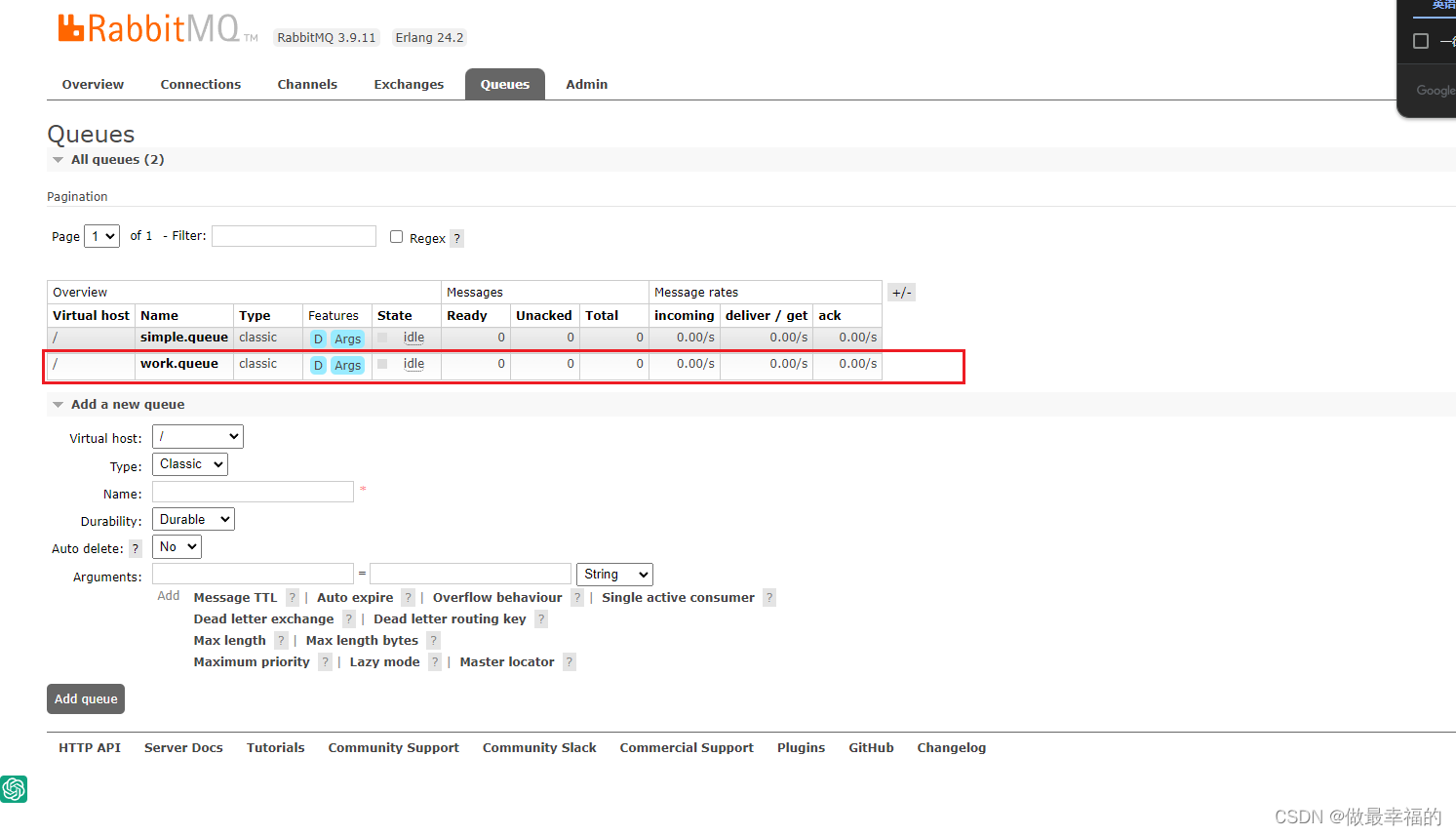
1.消息发送
这次我们循环发送,模拟大量消息堆积现象。
在publisher服务中的SpringAmqpTest类中添加一个测试方法:
/*** workQueue* 向队列中不停发送消息,模拟消息堆积。*/@Testpublic void testWorkQueue() throws InterruptedException {// 队列名称String queueName = "work.queue";// 消息String message = "hello, message_";for (int i = 0; i < 50; i++) {// 发送消息,每20毫秒发送一次,相当于每秒发送50条消息rabbitTemplate.convertAndSend(queueName, message + i);Thread.sleep(20);}}
2.消息接收
要模拟多个消费者绑定同一个队列,我们在consumer服务的SpringRabbitListener中添加2个新的方法:
@RabbitListener(queues = "work.queue")
public void listenWorkQueue1(String msg) throws InterruptedException {System.out.println("消费者1接收到消息:【" + msg + "】" + LocalTime.now());Thread.sleep(20);
}@RabbitListener(queues = "work.queue")
public void listenWorkQueue2(String msg) throws InterruptedException {System.err.println("消费者2........接收到消息:【" + msg + "】" + LocalTime.now());Thread.sleep(200);
}
注意到这两消费者,都设置了`Thead.sleep`,模拟任务耗时:
- 消费者1 sleep了20毫秒,相当于每秒钟处理50个消息
- 消费者2 sleep了200毫秒,相当于每秒处理5个消息
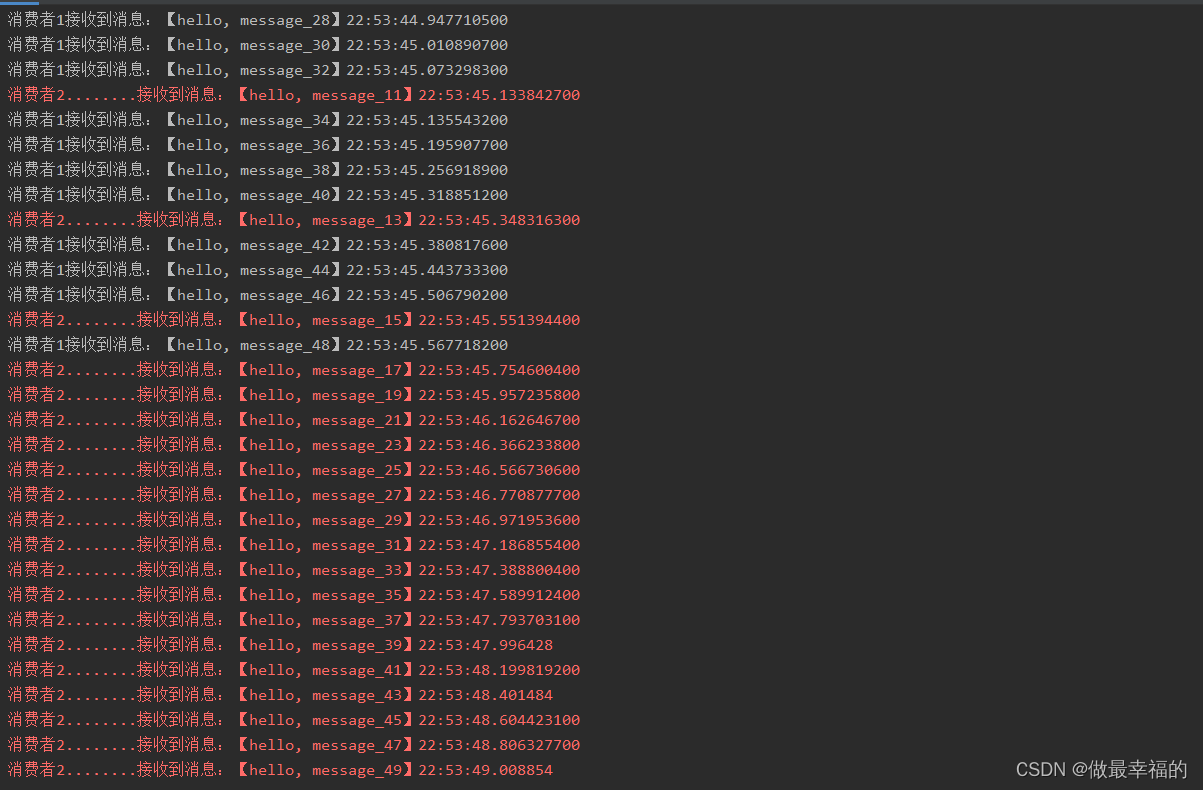
可以看到消费者1和消费者2竟然每人消费了25条消息:
- 消费者1很快完成了自己的25条消息
- 消费者2却在缓慢的处理自己的25条消息。
也就是说消息是平均分配给每个消费者,并没有考虑到消费者的处理能力。导致1个消费者空闲,另一个消费者忙的不可开交。没有充分利用每一个消费者的能力,最终消息处理的耗时远远超过了1秒。这样显然是有问题的。
3.能者多劳
在spring中有一个简单的配置,可以解决这个问题。我们修改consumer服务的application.yml文件,添加配置:
spring:rabbitmq:listener:simple:prefetch: 1 # 每次只能获取一条消息,处理完成才能获取下一个消息
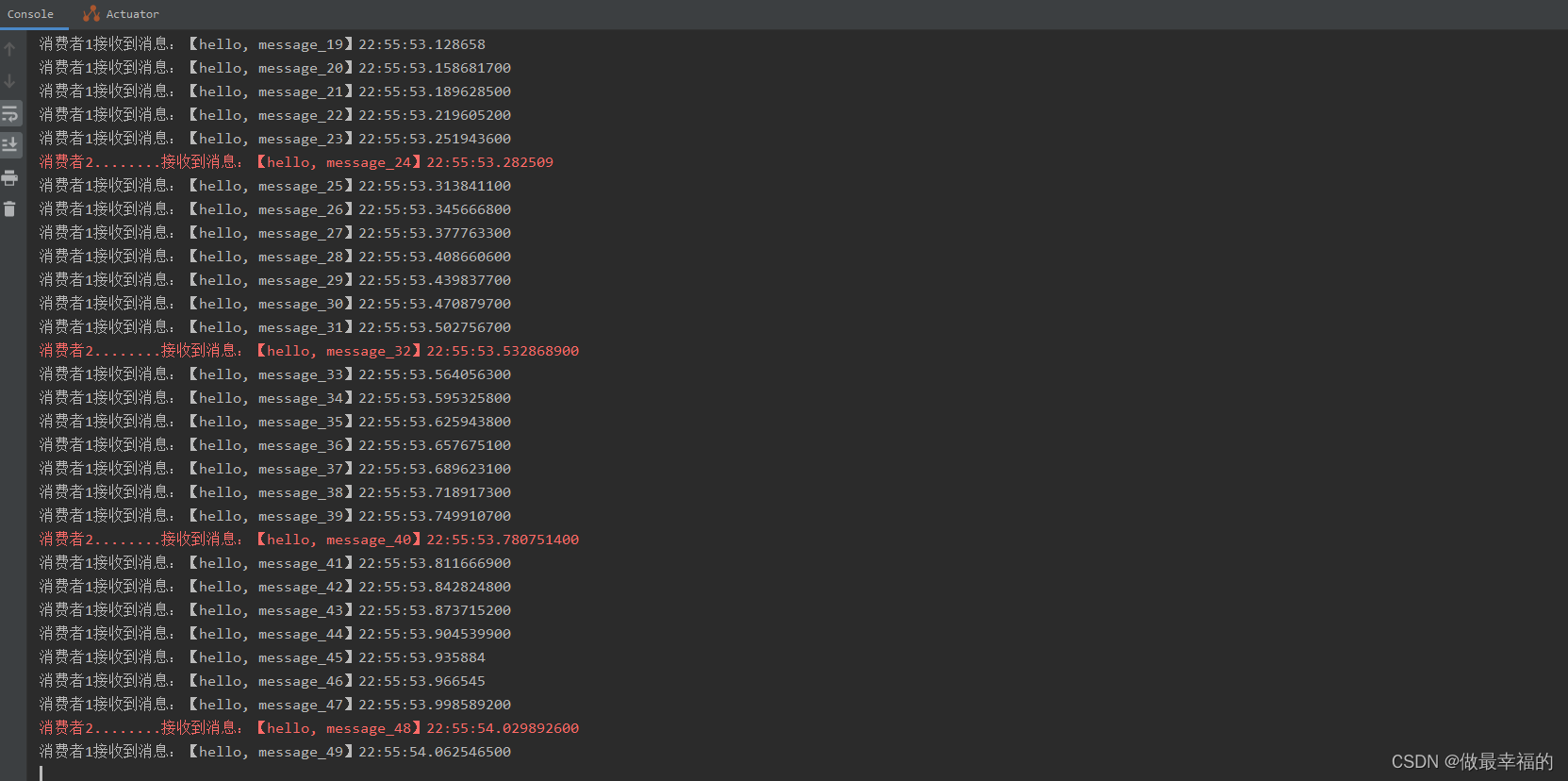
可以发现,由于消费者1处理速度较快,所以处理了更多的消息;消费者2处理速度较慢,只处理了6条消息。而最终总的执行耗时也在1秒左右,大大提升。正所谓能者多劳,这样充分利用了每一个消费者的处理能力,可以有效避免消息积压问题。
4.总结
Work模型的使用:
- 多个消费者绑定到一个队列,同一条消息只会被一个消费者处理
- 通过设置prefetch来控制消费者预取的消息数量
二.交换机类型
在之前的两个测试案例中,都没有交换机,生产者直接发送消息到队列。而一旦引入交换机,消息发送的模式会有很大变化:
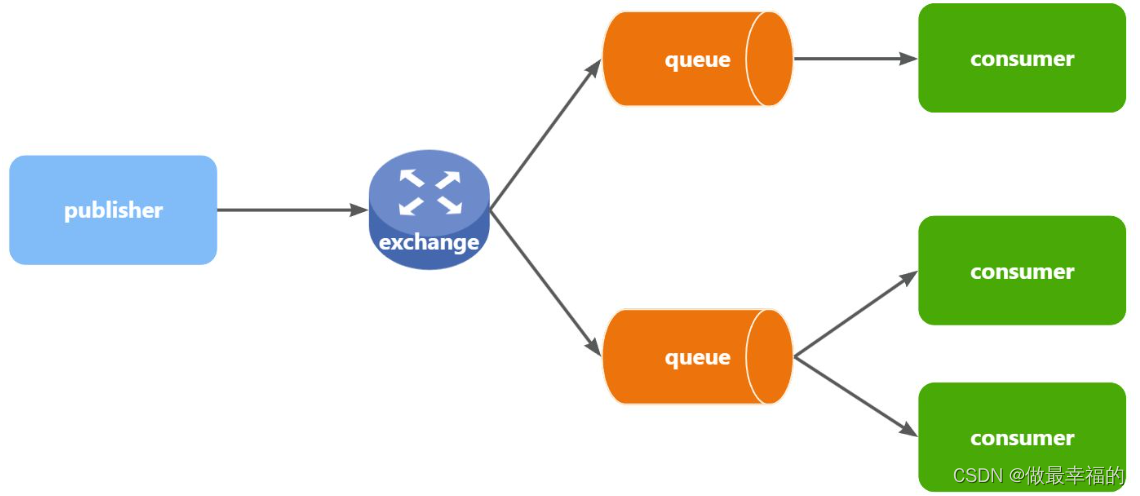
可以看到,在订阅模型中,多了一个exchange角色,而且过程略有变化:
- Publisher:生产者,不再发送消息到队列中,而是发给交换机
- Exchange:交换机,一方面,接收生产者发送的消息。另一方面,知道如何处理消息,例如递交给某个特别队列、递交给所有队列、或是将消息丢弃。到底如何操作,取决于Exchange的类型。
- Queue:消息队列也与以前一样,接收消息、缓存消息。不过队列一定要与交换机绑定。
- Consumer:消费者,与以前一样,订阅队列,没有变化
Exchange(交换机)只负责转发消息,不具备存储消息的能力,因此如果没有任何队列与Exchange绑定,或者没有符合路由规则的队列,那么消息会丢失!
交换机的类型有四种:
- Fanout:广播,将消息交给所有绑定到交换机的队列。我们最早在控制台使用的正是Fanout交换机
- Direct:订阅,基于RoutingKey(路由key)发送给订阅了消息的队列
- Topic:通配符订阅,与Direct类似,只不过RoutingKey可以使用通配符
- Headers:头匹配,基于MQ的消息头匹配,用的较少。
本次记录前面的三种交换机模式。
1.Fanout交换机
说明
Fanout,英文翻译是扇出,我觉得在MQ中叫广播更合适。
在广播模式下,消息发送流程是这样的:

- 1) 可以有多个队列
- 2) 每个队列都要绑定到Exchange(交换机)
- 3) 生产者发送的消息,只能发送到交换机
- 4) 交换机把消息发送给绑定过的所有队列
- 5) 订阅队列的消费者都能拿到消息
我们的计划是这样的:

- 创建一个名为
hmall.fanout的交换机,类型是Fanout - 创建两个队列
fanout.queue1和fanout.queue2,绑定到交换机hmall.fanout
1.在控制台增加两个新的队列
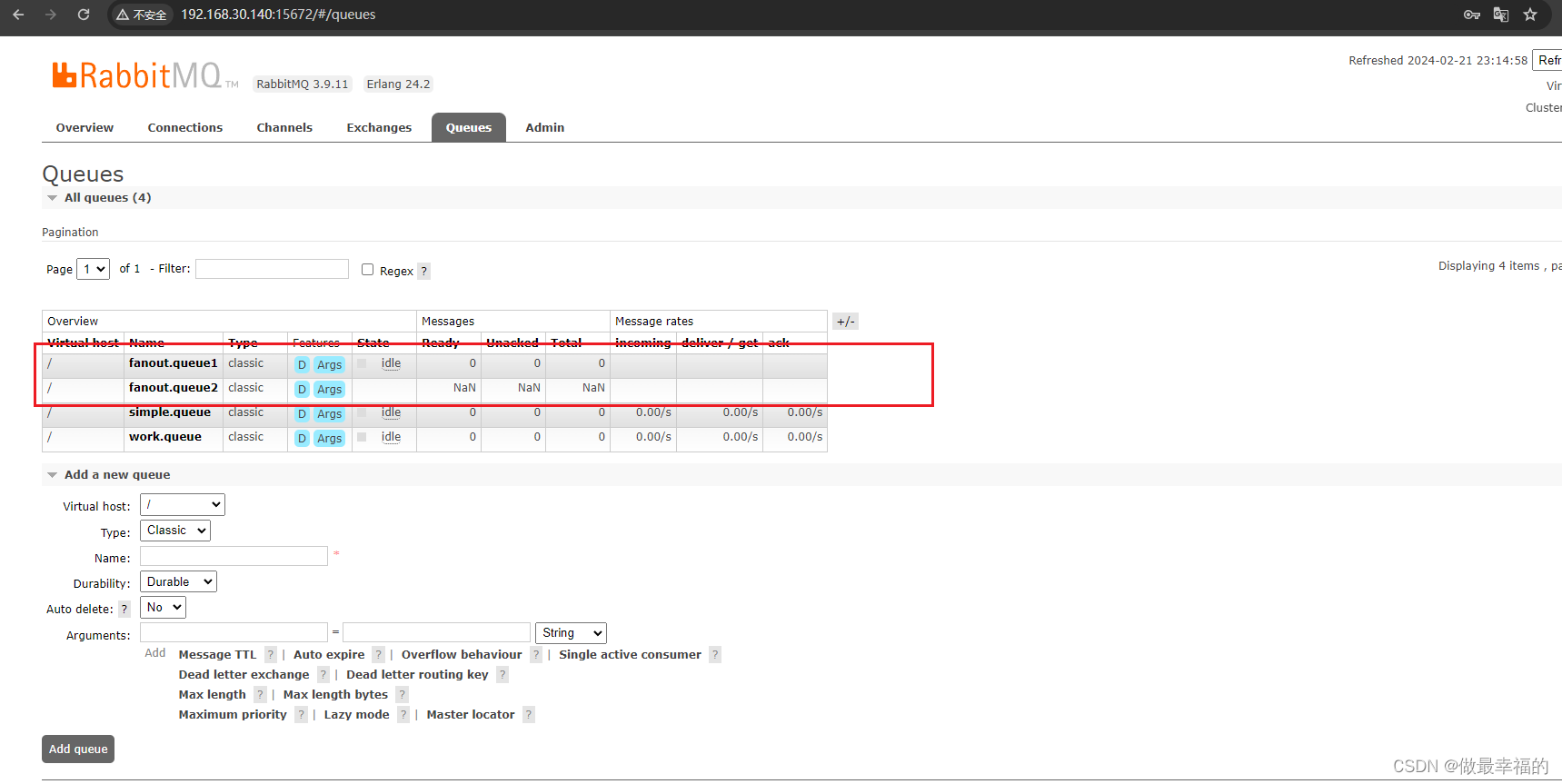
然后再创建一个交换机:

然后绑定两个队列到交换机:

测试
1.消息发送
在publisher服务的SpringAmqpTest类中添加测试方法:
@Test
public void testFanoutExchange() {// 交换机名称String exchangeName = "hmall.fanout";// 消息String message = "hello, everyone!";rabbitTemplate.convertAndSend(exchangeName, "", message);
}
2.消息接收
在consumer服务的SpringRabbitListener中添加两个方法,作为消费者:
@RabbitListener(queues = "fanout.queue1")
public void listenFanoutQueue1(String msg) {System.out.println("消费者1接收到Fanout消息:【" + msg + "】");
}@RabbitListener(queues = "fanout.queue2")
public void listenFanoutQueue2(String msg) {System.out.println("消费者2接收到Fanout消息:【" + msg + "】");
}

3.总结
交换机的作用是什么?
- 接收publisher发送的消息
- 将消息按照规则路由到与之绑定的队列
- 不能缓存消息,路由失败,消息丢失
- FanoutExchange的会将消息路由到每个绑定的队列
2.Direct交换机
说明
在Fanout模式中,一条消息,会被所有订阅的队列都消费。但是,在某些场景下,我们希望不同的消息被不同的队列消费。这时就要用到Direct类型的Exchange。

在Direct模型下:
- 队列与交换机的绑定,不能是任意绑定了,而是要指定一个
RoutingKey(路由key) - 消息的发送方在 向 Exchange发送消息时,也必须指定消息的
RoutingKey。 - Exchange不再把消息交给每一个绑定的队列,而是根据消息的
Routing Key进行判断,只有队列的Routingkey与消息的Routing key完全一致,才会接收到消息
案例需求如图:
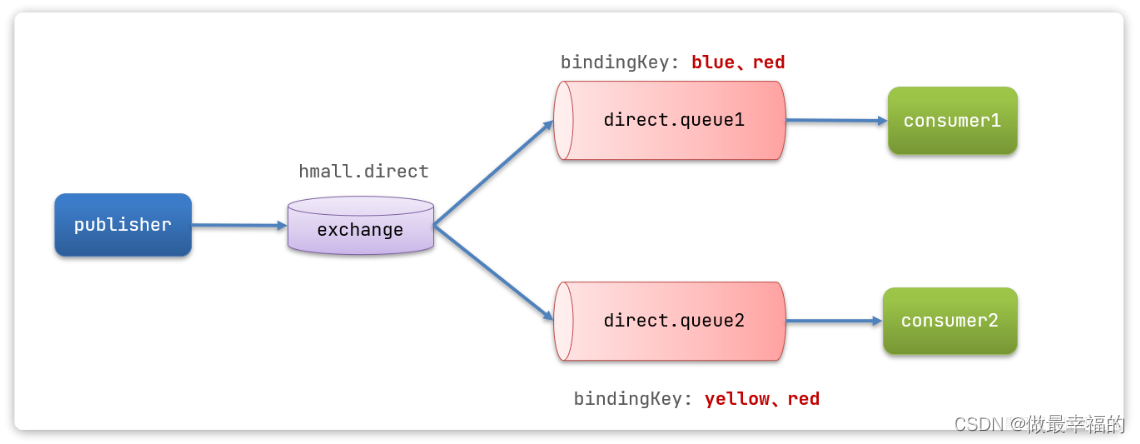
- 声明一个名为
hmall.direct的交换机 - 声明队列
direct.queue1,绑定hmall.direct,bindingKey为blud和red - 声明队列
direct.queue2,绑定hmall.direct,bindingKey为yellow和red - 在
consumer服务中,编写两个消费者方法,分别监听direct.queue1和direct.queue2 - 在publisher中编写测试方法,向
hmall.direct发送消息
声明队列和交换机
首先在控制台声明两个队列direct.queue1和direct.queue2

然后声明一个direct类型的交换机,命名为hmall.direct:
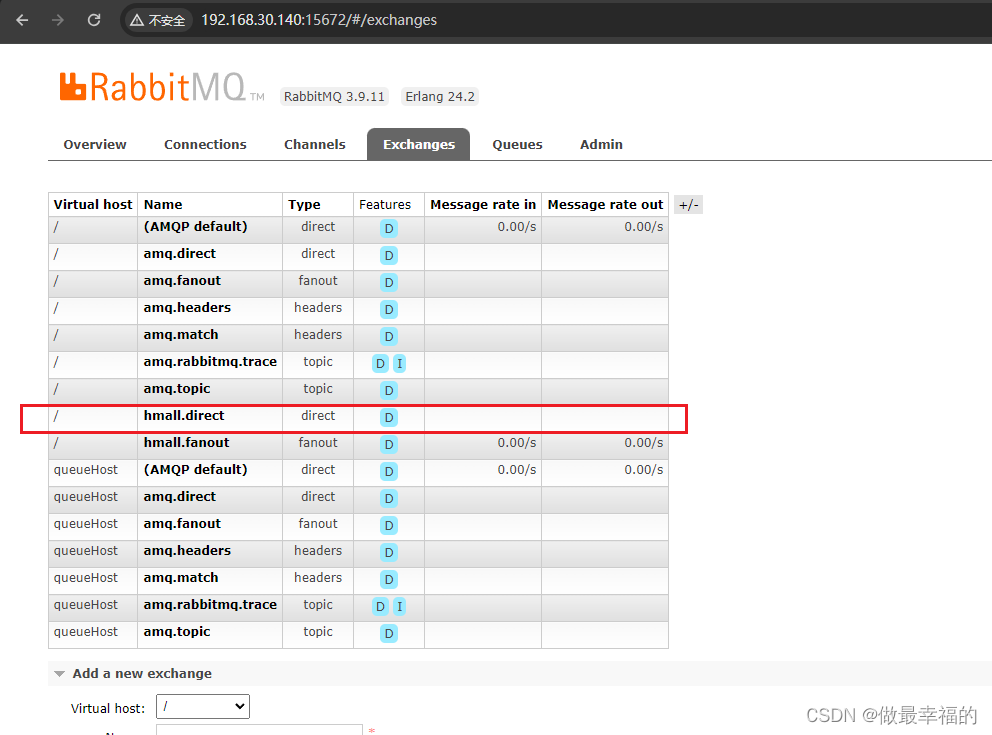
然后使用red和blue作为key,绑定direct.queue1到hmall.direct:
同理,使用red和yellow作为key,绑定direct.queue2到hmall.direct,步骤略,最终结果:

测试
1.消息发送
在publisher服务的SpringAmqpTest类中添加测试方法:
@Test
public void testSendDirectExchange() {// 交换机名称String exchangeName = "hmall.direct";// 消息String message = "红色警报!日本乱排核废水,导致海洋生物变异,惊现哥斯拉!";// 发送消息rabbitTemplate.convertAndSend(exchangeName, "red", message);
}
2.消息接收
在consumer服务的SpringRabbitListener中添加方法:
@RabbitListener(queues = "direct.queue1")
public void listenDirectQueue1(String msg) {System.out.println("消费者1接收到direct.queue1的消息:【" + msg + "】");
}@RabbitListener(queues = "direct.queue2")
public void listenDirectQueue2(String msg) {System.out.println("消费者2接收到direct.queue2的消息:【" + msg + "】");
}
由于使用的red这个key,所以两个消费者都收到了消息:
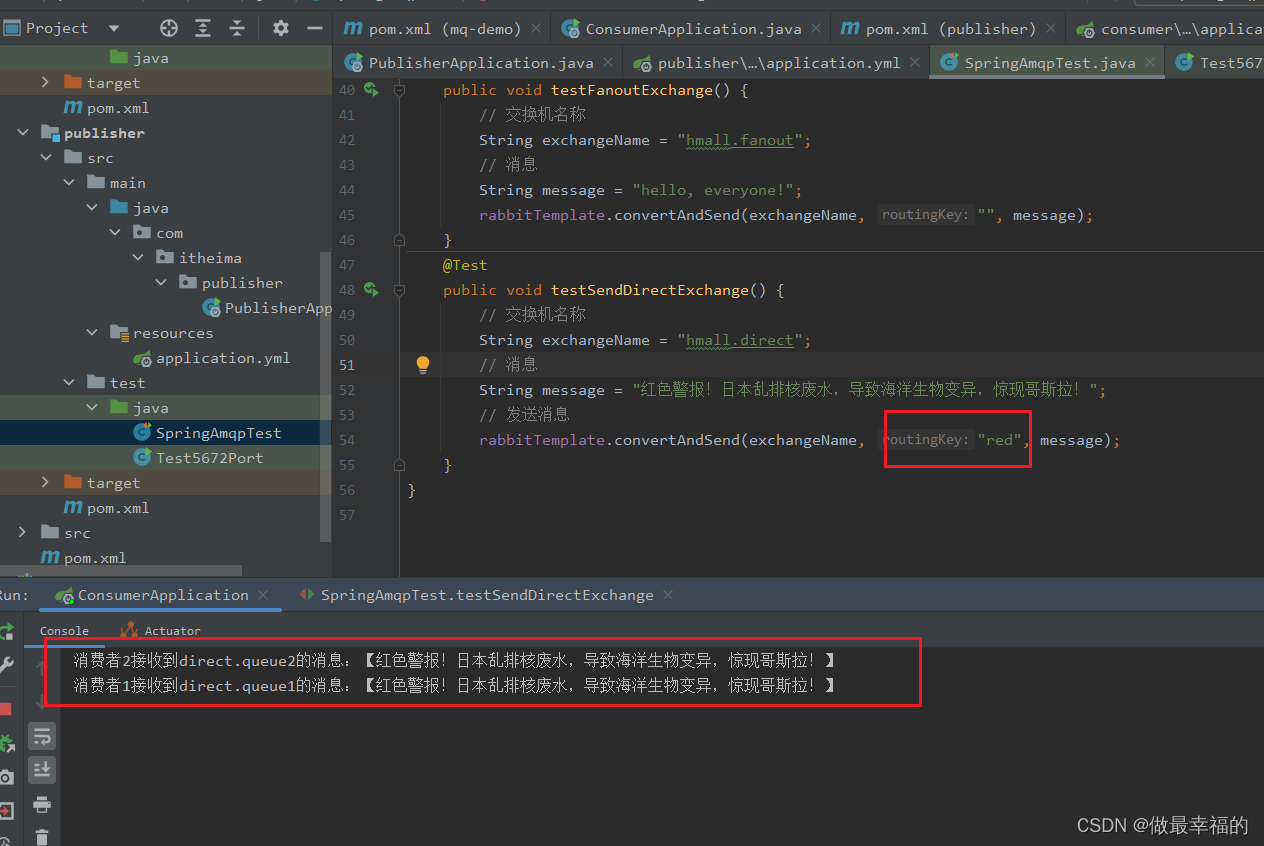
我们再切换为blue这个key:
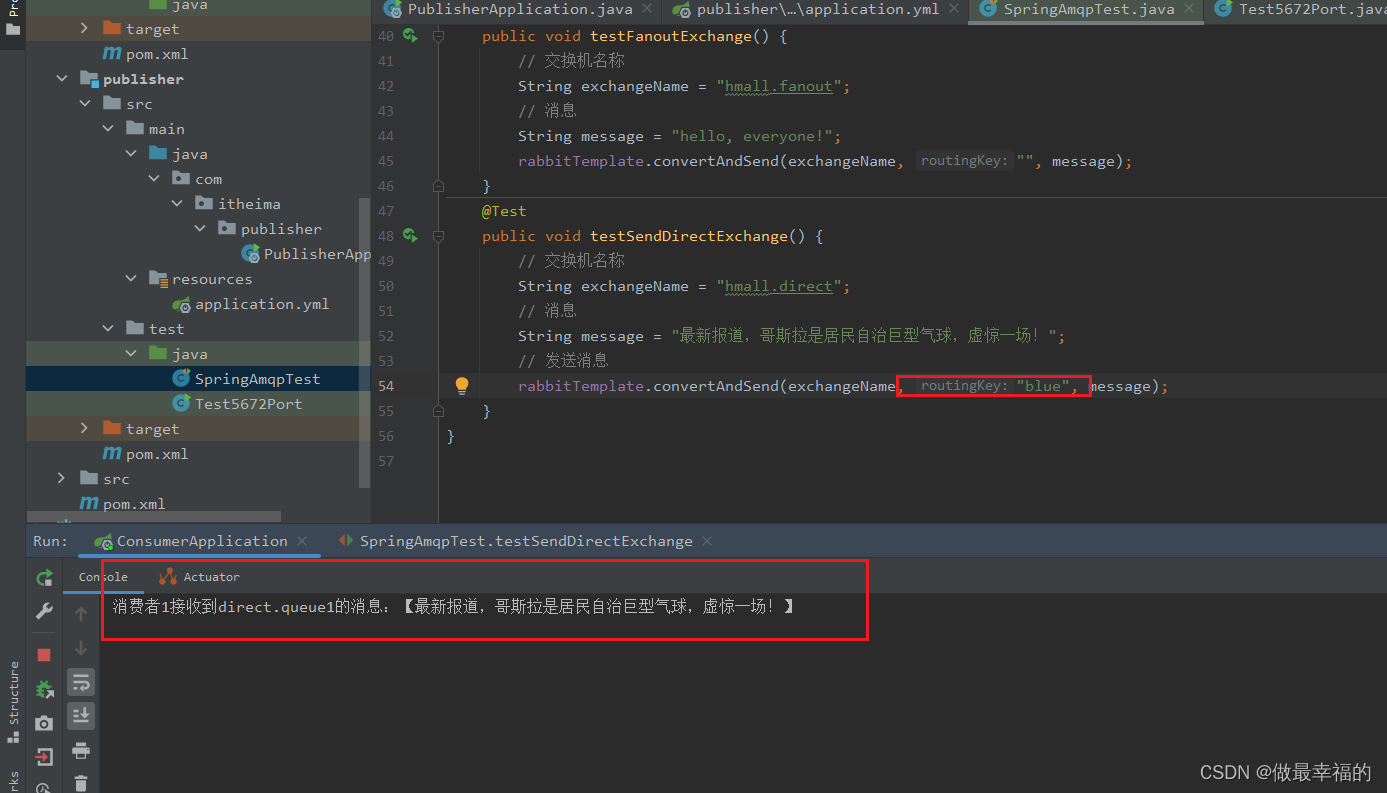
3.总结
描述下Direct交换机与Fanout交换机的差异?
- Fanout交换机将消息路由给每一个与之绑定的队列
- Direct交换机根据RoutingKey判断路由给哪个队列
- 如果多个队列具有相同的RoutingKey,则与Fanout功能类似
3.Topic交换机
说明
Topic类型的Exchange与Direct相比,都是可以根据RoutingKey把消息路由到不同的队列。
只不过Topic类型Exchange可以让队列在绑定RoutingKey 的时候使用通配符!
RoutingKey 一般都是有一个或多个单词组成,多个单词之间以.分割,例如: item.insert
通配符规则:
#:匹配一个或多个词*:匹配不多不少恰好1个词
举例:
item.#:能够匹配item.spu.insert或者item.spuitem.*:只能匹配item.spu

测试
假如此时publisher发送的消息使用的RoutingKey共有四种:
china.news代表有中国的新闻消息;china.weather代表中国的天气消息;japan.news则代表日本新闻japan.weather代表日本的天气消息;
解释:
topic.queue1:绑定的是china.#,凡是以china.开头的routing key都会被匹配到,包括:china.newschina.weather
topic.queue2:绑定的是#.news,凡是以.news结尾的routing key都会被匹配。包括:china.newsjapan.news
接下来,我们就按照上图所示,来演示一下Topic交换机的用法。
首先,在控制台按照图示例子创建队列、交换机,并利用通配符绑定队列和交换机。此处步骤略。最终结果如下:
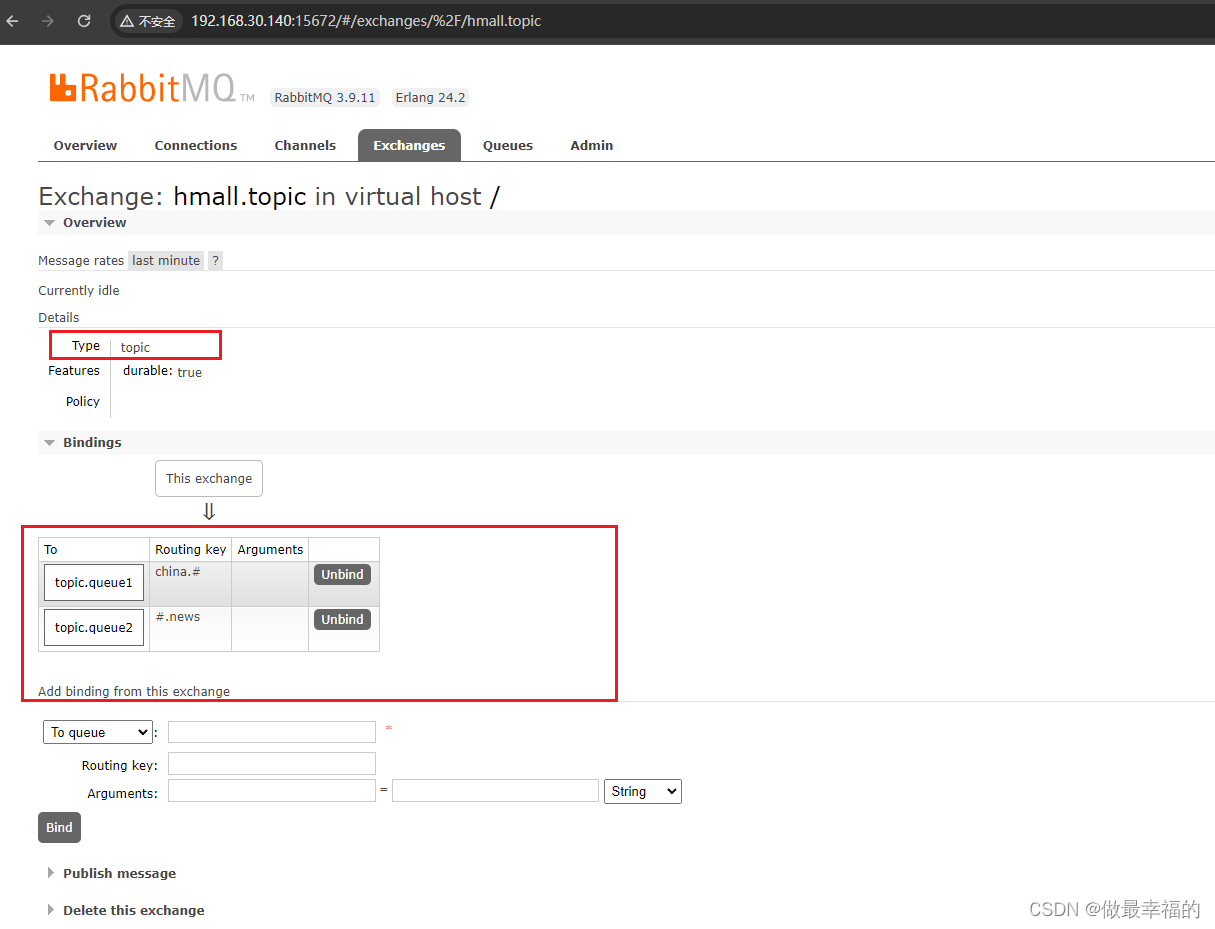
1.消息发送
在publisher服务的SpringAmqpTest类中添加测试方法:
/*** topicExchange*/
@Test
public void testSendTopicExchange() {// 交换机名称String exchangeName = "hmall.topic";// 消息String message = "喜报!孙悟空大战哥斯拉,胜!";// 发送消息rabbitTemplate.convertAndSend(exchangeName, "china.news", message);
}
2.消息接收
@RabbitListener(queues = "topic.queue1")
public void listenTopicQueue1(String msg){System.out.println("消费者1接收到topic.queue1的消息:【" + msg + "】");
}@RabbitListener(queues = "topic.queue2")
public void listenTopicQueue2(String msg){System.out.println("消费者2接收到topic.queue2的消息:【" + msg + "】");
}
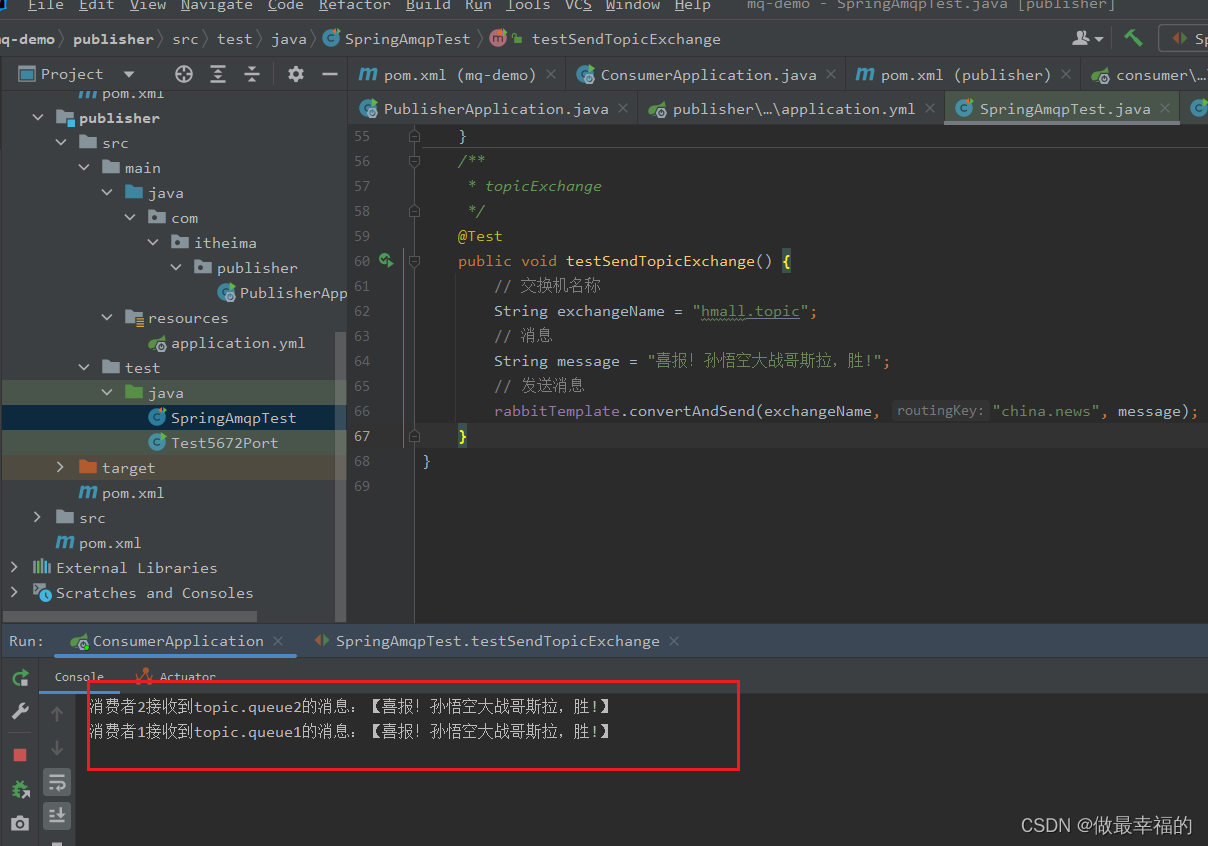
3.总结
描述下Direct交换机与Topic交换机的差异?
- Topic交换机接收的消息RoutingKey必须是多个单词,以
**.**分割 - Topic交换机与队列绑定时的bindingKey可以指定通配符
#:代表0个或多个词*:代表1个词
4.声明队列和交换机
在之前我们都是基于RabbitMQ控制台来创建队列、交换机。但是在实际开发时,队列和交换机是程序员定义的,将来项目上线,又要交给运维去创建。那么程序员就需要把程序中运行的所有队列和交换机都写下来,交给运维。在这个过程中是很容易出现错误的。
因此推荐的做法是由程序启动时检查队列和交换机是否存在,如果不存在自动创建。
1.基本API
SpringAMQP提供了一个Queue类,用来创建队列

SpringAMQP还提供了一个Exchange接口,来表示所有不同类型的交换机:


我们可以自己创建队列和交换机,不过SpringAMQP还提供了ExchangeBuilder来简化这个过程:
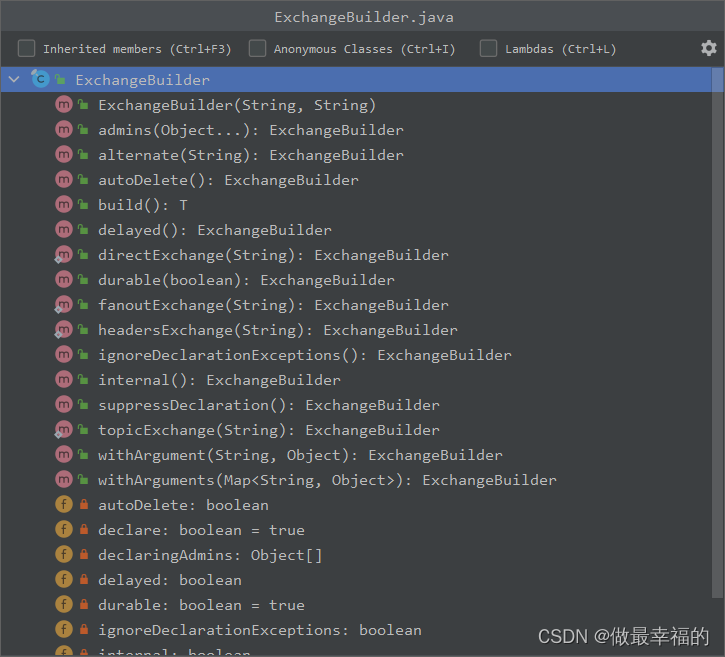
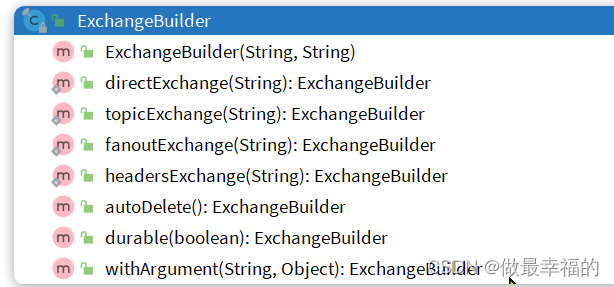
而在绑定队列和交换机时,则需要使用BindingBuilder来创建Binding对象: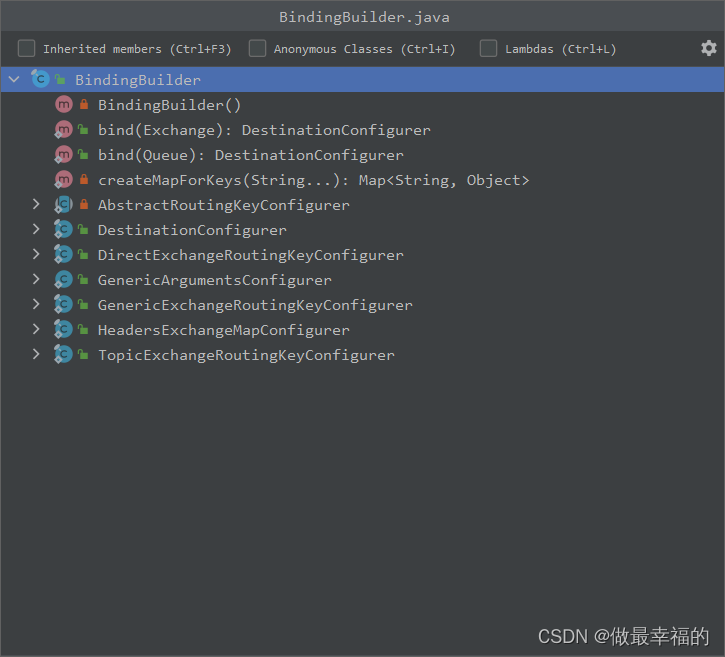

1.fanout示例
import org.springframework.amqp.core.Binding;
import org.springframework.amqp.core.BindingBuilder;
import org.springframework.amqp.core.FanoutExchange;
import org.springframework.amqp.core.Queue;
import org.springframework.context.annotation.Bean;
import org.springframework.context.annotation.Configuration;@Configuration
public class FanoutConfig {/*** 声明交换机* @return Fanout类型交换机*/@Beanpublic FanoutExchange fanoutExchange(){return new FanoutExchange("hmall.fanout");}/*** 第1个队列*/@Beanpublic Queue fanoutQueue1(){return new Queue("fanout.queue1");}/*** 绑定队列和交换机*/@Beanpublic Binding bindingQueue1(Queue fanoutQueue1, FanoutExchange fanoutExchange){return BindingBuilder.bind(fanoutQueue1).to(fanoutExchange);}/*** 第2个队列*/@Beanpublic Queue fanoutQueue2(){return new Queue("fanout.queue2");}/*** 绑定队列和交换机*/@Beanpublic Binding bindingQueue2(Queue fanoutQueue2, FanoutExchange fanoutExchange){return BindingBuilder.bind(fanoutQueue2).to(fanoutExchange);}
}
2.direct示例
direct模式由于要绑定多个KEY,会非常麻烦,每一个Key都要编写一个binding:
import org.springframework.amqp.core.*;
import org.springframework.context.annotation.Bean;
import org.springframework.context.annotation.Configuration;@Configuration
public class DirectConfig {/*** 声明交换机* @return Direct类型交换机*/@Beanpublic DirectExchange directExchange(){return ExchangeBuilder.directExchange("hmall.direct").build();}/*** 第1个队列*/@Beanpublic Queue directQueue1(){return new Queue("direct.queue1");}/*** 绑定队列和交换机*/@Beanpublic Binding bindingQueue1WithRed(Queue directQueue1, DirectExchange directExchange){return BindingBuilder.bind(directQueue1).to(directExchange).with("red");}/*** 绑定队列和交换机*/@Beanpublic Binding bindingQueue1WithBlue(Queue directQueue1, DirectExchange directExchange){return BindingBuilder.bind(directQueue1).to(directExchange).with("blue");}/*** 第2个队列*/@Beanpublic Queue directQueue2(){return new Queue("direct.queue2");}/*** 绑定队列和交换机*/@Beanpublic Binding bindingQueue2WithRed(Queue directQueue2, DirectExchange directExchange){return BindingBuilder.bind(directQueue2).to(directExchange).with("red");}/*** 绑定队列和交换机*/@Beanpublic Binding bindingQueue2WithYellow(Queue directQueue2, DirectExchange directExchange){return BindingBuilder.bind(directQueue2).to(directExchange).with("yellow");}
}
3.基于注解声明
基于@Bean的方式声明队列和交换机比较麻烦,Spring还提供了基于注解方式来声明。
例如,我们同样声明Direct模式的交换机和队列:
@RabbitListener(bindings = @QueueBinding(value = @Queue(name = "direct.queue1"),exchange = @Exchange(name = "hmall.direct", type = ExchangeTypes.DIRECT),key = {"red", "blue"}
))
public void listenDirectQueue1(String msg){System.out.println("消费者1接收到direct.queue1的消息:【" + msg + "】");
}@RabbitListener(bindings = @QueueBinding(value = @Queue(name = "direct.queue2"),exchange = @Exchange(name = "hmall.direct", type = ExchangeTypes.DIRECT),key = {"red", "yellow"}
))
public void listenDirectQueue2(String msg){System.out.println("消费者2接收到direct.queue2的消息:【" + msg + "】");
}
再试试Topic模式:
@RabbitListener(bindings = @QueueBinding(value = @Queue(name = "topic.queue1"),exchange = @Exchange(name = "hmall.topic", type = ExchangeTypes.TOPIC),key = "china.#"
))
public void listenTopicQueue1(String msg){System.out.println("消费者1接收到topic.queue1的消息:【" + msg + "】");
}@RabbitListener(bindings = @QueueBinding(value = @Queue(name = "topic.queue2"),exchange = @Exchange(name = "hmall.topic", type = ExchangeTypes.TOPIC),key = "#.news"
))
public void listenTopicQueue2(String msg){System.out.println("消费者2接收到topic.queue2的消息:【" + msg + "】");
}
4.消息转换器
Spring的消息发送代码接收的消息体是一个Object:
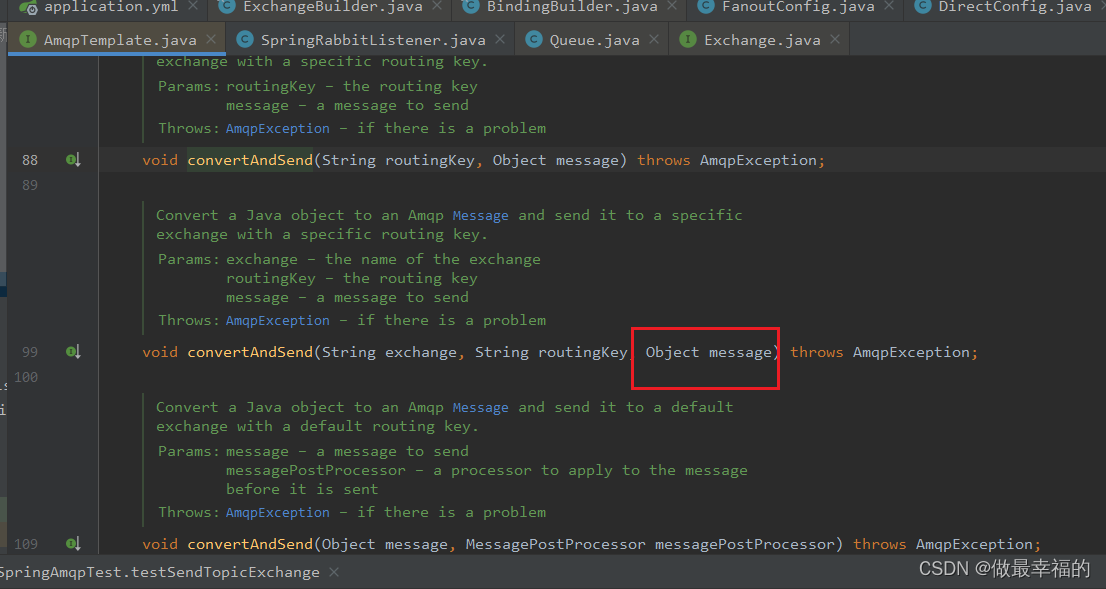
而在数据传输时,它会把你发送的消息序列化为字节发送给MQ,接收消息的时候,还会把字节反序列化为Java对象。只不过,默认情况下Spring采用的序列化方式是JDK序列化。众所周知,JDK序列化存在下列问题:
- 数据体积过大
- 有安全漏洞
- 可读性差
我们来测试一下。
1)创建测试队列
首先,我们在consumer服务中声明一个新的配置类:
import org.springframework.amqp.core.Queue;
import org.springframework.context.annotation.Bean;
import org.springframework.context.annotation.Configuration;@Configuration
public class MessageConfig {@Beanpublic Queue objectQueue() {return new Queue("object.queue");}
}
注意,这里我们先不要给这个队列添加消费者,我们要查看消息体的格式。
重启consumer服务以后,该队列就会被自动创建出来了:
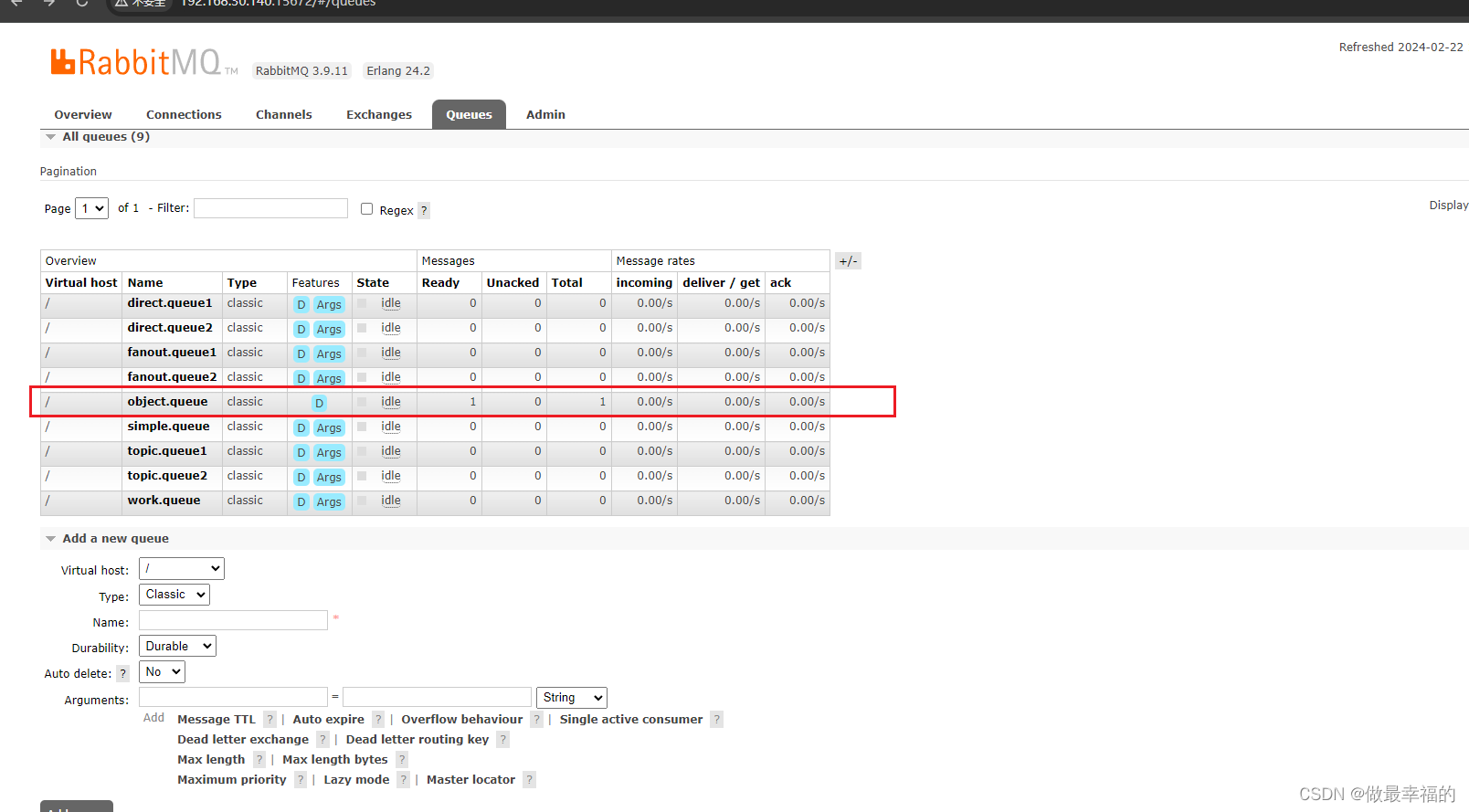
2)发送消息
我们在publisher模块的SpringAmqpTest中新增一个消息发送的代码,发送一个Map对象:
@Test
public void testSendMap() throws InterruptedException {// 准备消息Map<String,Object> msg = new HashMap<>();msg.put("name", "柳岩");msg.put("age", 21);// 发送消息rabbitTemplate.convertAndSend("object.queue", msg);
}
发送消息后查看控制台:
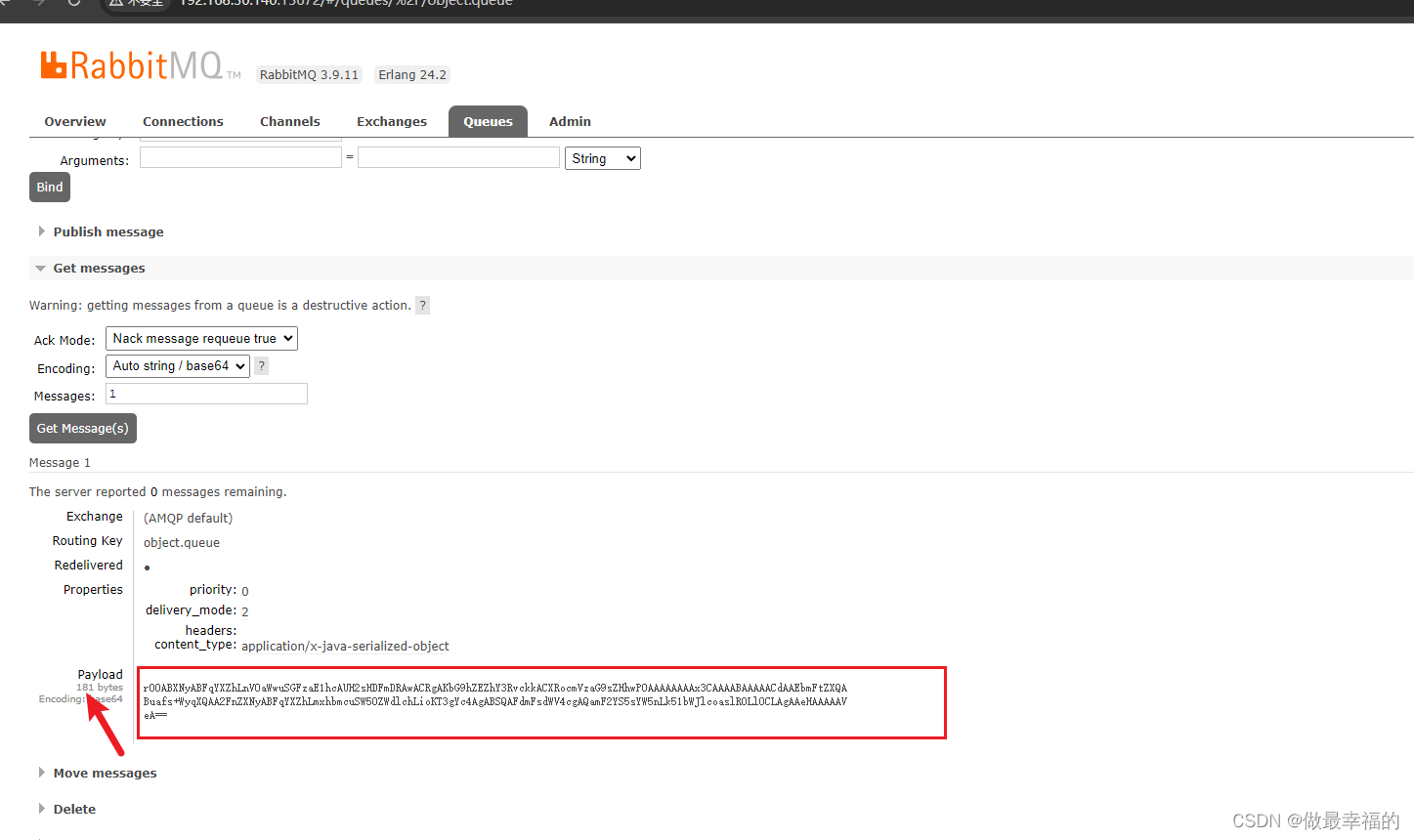
可以看到消息格式非常不友好。
1.配置JSON转换器
显然,JDK序列化方式并不合适。我们希望消息体的体积更小、可读性更高,因此可以使用JSON方式来做序列化和反序列化。
在publisher和consumer两个服务中都引入依赖:
<dependency><groupId>com.fasterxml.jackson.dataformat</groupId><artifactId>jackson-dataformat-xml</artifactId><version>2.9.10</version>
</dependency>
注意,如果项目中引入了spring-boot-starter-web依赖,则无需再次引入Jackson依赖。
配置消息转换器,在publisher和consumer两个服务的启动类中添加一个Bean即可:
@Bean
public MessageConverter messageConverter(){// 1.定义消息转换器Jackson2JsonMessageConverter jackson2JsonMessageConverter = new Jackson2JsonMessageConverter();// 2.配置自动创建消息id,用于识别不同消息,也可以在业务中基于ID判断是否是重复消息jackson2JsonMessageConverter.setCreate MessageIds(true);return jackson2JsonMessageConverter;
}
消息转换器中添加的messageId可以便于我们将来做幂等性判断。
此时,我们到MQ控制台删除object.queue中的旧的消息。然后再次执行刚才的消息发送的代码,到MQ的控制台查看消息结构:
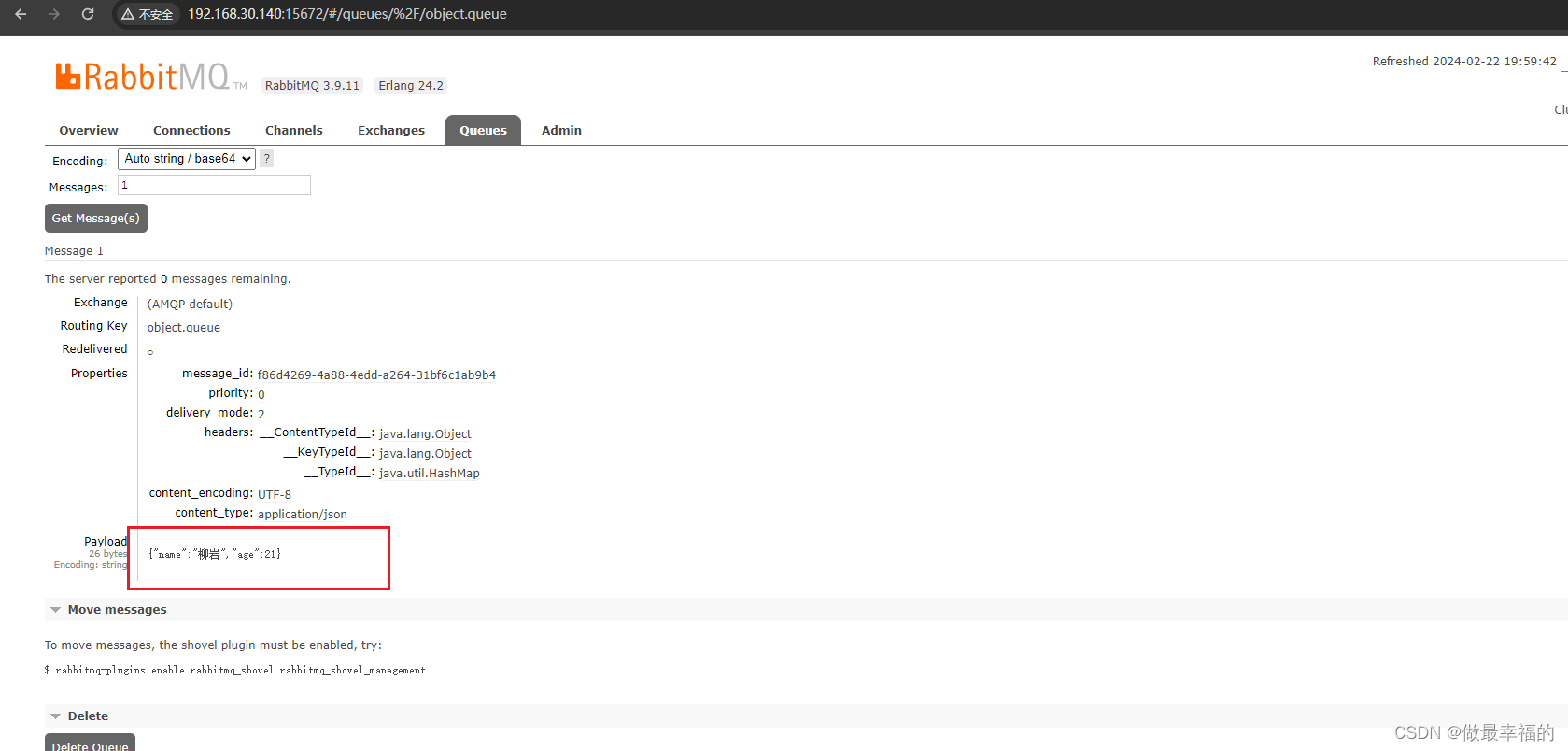
2.消费者接收Object
@RabbitListener(queues = "object.queue")
public void listenSimpleQueueMessage(Map<String, Object> msg) throws InterruptedException {System.out.println("消费者接收到object.queue消息:【" + msg + "】");
}











---图像变换和增强)
)


)



